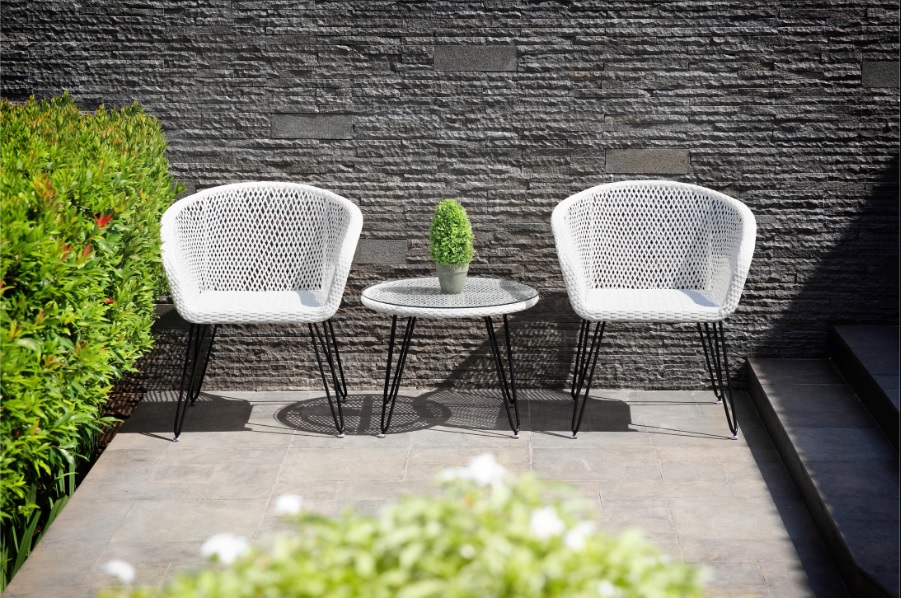Why Rattan Outdoor Furniture Matters
Outdoor spaces have transformed over the past decade. No longer just lawns or balconies, they have become extensions of our homes—sanctuaries for rest, entertainment, and even remote work. This evolution has driven a surge in demand for stylish, durable, and eco-conscious outdoor furnishings. And at the heart of this shift lies one material: rattan.
Rattan outdoor furniture isn’t just a trend; it’s a global phenomenon. From chic patios in Los Angeles to sun-drenched villas in Bali, rattan has become synonymous with natural luxury and sustainable elegance. This article explores the essence, craftsmanship, global market, and future of rattan outdoor furniture, offering a detailed look into why it’s an ideal choice for both consumers and designers.
Understanding Rattan: Origins and Natural Strength
Rattan is a naturally renewable palm native to Southeast Asia, primarily found in countries like Indonesia, the Philippines, and Malaysia. Unlike bamboo, which is hollow, rattan is solid and flexible, making it perfect for weaving and shaping into furniture.
This vine-like plant grows rapidly in forested areas and requires little intervention, making it an eco-friendly raw material. Harvesting rattan does not require clearing forests—meaning it promotes biodiversity and sustainable livelihoods in rural communities.
Natural rattan features a smooth surface, strong fibrous core, and the ability to absorb finishes like stains or paint, which makes it extremely versatile in design. Although traditionally used indoors, its adaptation for outdoor furniture has created a hybrid of style and resilience.
The Craftsmanship Behind Outdoor Rattan Furniture
The true beauty of rattan furniture lies in its craftsmanship. Skilled artisans in regions such as Cirebon, Indonesia, and Cebu, Philippines, have passed down weaving techniques for generations. These artisans hand-bend rattan frames, steam and mold the stems, and intricately weave the material into stunning pieces of art.
Creating outdoor-grade rattan furniture involves several advanced processes:
Synthetic Rattan Innovation
To combat the elements—rain, UV rays, moisture—manufacturers have developed high-quality synthetic rattan (also known as PE rattan or resin wicker). It mimics the natural appearance of rattan while offering superior durability.
Aluminum or Teak Frames
For structural stability, outdoor rattan furniture is usually built on powder-coated aluminum or solid teak frames. These materials resist rust and decay, enhancing the longevity of the furniture.
UV and Weather Resistance Treatment
The synthetic strands are treated to prevent fading or cracking under sun exposure. Combined with waterproof cushions and quick-dry foam, this makes rattan furniture suitable for year-round outdoor use.
Global Market Trends and Demand
Rattan outdoor furniture has seen a substantial rise in demand across continents due to several interrelated trends:
- Eco-conscious consumerism: The growing preference for sustainable materials has boosted natural and synthetic rattan alike.
- Biophilic design principles: Architects and designers are increasingly incorporating nature-inspired elements—like rattan—into both residential and commercial projects.
- Remote work culture: As people spend more time at home, outdoor spaces have become personalized escapes, increasing demand for stylish and functional furniture.
According to a 2024 report from Grand View Research, the global outdoor furniture market was valued at over $50 billion, with rattan outdoor furniture being one of the fastest-growing segments. North America, Europe, and Southeast Asia dominate the demand, with rising interest from Africa and the Middle East.
Design Versatility and Aesthetic Appeal
Rattan’s timeless texture and natural look complement a wide range of design styles—from coastal and boho to minimalist and rustic. This versatility makes it a favorite among interior designers and hospitality architects.
Outdoor rattan furniture comes in various finishes, including:
- Bohemian-inspired whitewashed rattan for coastal villas
- Sleek black synthetic wicker for contemporary terraces
- Natural honey tones for tropical resorts
The furniture styles vary from lounge chairs, daybeds, dining sets, and hanging egg chairs to entire outdoor sectionals. This wide range of options allows designers and homeowners to create cohesive, stylish outdoor settings that reflect individual personalities or brand identity.
Key Benefits of Rattan Outdoor Furniture
Among all materials available for outdoor use, rattan stands out for several compelling reasons:
- Lightweight yet strong: Rattan is easy to move and rearrange while being robust enough to withstand daily use.
- Sustainable sourcing: Natural rattan grows rapidly and requires minimal chemical processing.
- Eco-friendly production: Both natural and synthetic rattan production generally has a smaller carbon footprint compared to plastic or metal furniture.
- Weather resistance: High-grade synthetic rattan can withstand extreme heat, humidity, and rain without losing its aesthetic appeal.
- Low maintenance: Simple cleaning with a soft brush and mild soap is enough to maintain the furniture for years.
Rattan vs Other Outdoor Furniture Materials
It’s important to compare rattan to other materials commonly used in outdoor furniture to understand its strengths and limitations.
- Rattan vs Metal: Metal (especially wrought iron) is sturdy but prone to rust without special coatings. Rattan, particularly synthetic variants, resists rust naturally and is more visually organic.
- Rattan vs Plastic: Plastic is waterproof and low-cost but lacks the charm and sophistication of rattan.
- Rattan vs Wood: Teak and acacia are popular hardwoods, but they require frequent sealing or oiling. Synthetic rattan, on the other hand, maintains its appearance with minimal care.
In essence, rattan provides the best of both worlds: aesthetic beauty and practical durability.
Manufacturing Powerhouses: Where the World Sources Rattan Furniture
Indonesia
Indonesia remains the largest producer and exporter of both natural and synthetic rattan furniture. The island of Java, particularly the city of Cirebon, is renowned for its artisan weavers. Many global brands source their outdoor collections from manufacturers here due to quality, design flexibility, and sustainable sourcing certifications like SVLK, FSC, and BSCI.
Philippines
Cebu has long been a leader in high-end woven furniture. Filipino craftsmen combine modern design with traditional craftsmanship, producing pieces for luxury resorts and boutique hotels worldwide.
Vietnam and Malaysia
These countries have grown rapidly in rattan production, offering competitive pricing and scaling capabilities. Vietnamese factories often blend rattan with hardwood elements, catering to European tastes.
Hospitality Sector and Project Furniture
One of the biggest adopters of rattan outdoor furniture is the hospitality industry. Hotels, resorts, beach clubs, and cafes opt for rattan due to its tropical allure and photo-friendly aesthetics.
Project furniture suppliers often partner with architects to deliver fully customized rattan furniture collections, including:
- Modular sofas tailored to poolside layouts
- Stackable rattan dining chairs for open-air restaurants
- Sun loungers with waterproof cushions for luxury resorts
Such furniture often adheres to strict standards of fire retardancy, commercial-grade strength, and modular versatility.
Rattan in Outdoor Home Decor and Lifestyle Branding
Instagram, Pinterest, and lifestyle magazines are filled with rattan-forward outdoor spaces. Brands use rattan furniture to evoke a sense of relaxed sophistication, nature-loving simplicity, and curated living.
Rattan pieces are frequently styled with:
- Earth-toned cushions
- Neutral rugs
- Potted greenery
- Rattan lanterns and accessories
This aesthetic taps into the broader slow living and boho chic movement, where outdoor spaces are designed to offer mental rest and natural connection.
Common Challenges and Misconceptions
Despite its advantages, rattan outdoor furniture comes with a few considerations:
- Misunderstanding between natural and synthetic: Many buyers confuse indoor rattan with weather-resistant outdoor variants. Natural rattan will degrade if left outside long-term.
- Quality differences among synthetic materials: Not all PE rattan is equal. Lower-grade synthetic rattan may crack, fade, or unravel under constant sun exposure.
- Maintenance assumptions: While rattan is low-maintenance, cushions and frames still need occasional care.
To avoid these issues, buyers should ensure that the rattan furniture they choose comes from reputable suppliers with proven weather-resistance ratings and UV certifications.
How to Choose the Best Rattan Outdoor Furniture
Buyers, both retail and wholesale, should evaluate:
- Material quality: Look for UV-protected PE rattan, aluminum or teak frames, and outdoor-grade cushion foam.
- Weaving craftsmanship: Handwoven pieces often have tighter, more consistent weaves than machine-woven ones.
- Certifications: FSC, BSCI, REACH, or SVLK certifications signal ethical sourcing and production.
- Customization: For large projects, the ability to customize dimensions, cushion fabrics, and finishes can make a big difference.
- Shipping readiness: Trusted manufacturers ensure export-safe packaging and support full-container-load orders for wholesale customers.
Sustainability and the Future of Outdoor Furniture
As climate change and environmental awareness continue to shape consumer decisions, rattan furniture’s sustainable roots become even more critical. Innovations in biodegradable synthetic fibers and the circular design economy are expected to push rattan to the forefront of ethical design.
Many manufacturers have also begun offering:
- Furniture buyback or recycling programs
- Cradle-to-cradle design strategies
- Carbon offset partnerships with global reforestation projects
This aligns with the growing consumer interest in regenerative furniture—products that don’t just reduce harm but actively restore ecosystems.
Case Studies: Real-World Applications
A Luxury Resort in the Maldives
The architects of a five-star resort partnered with an Indonesian rattan manufacturer to create all their outdoor lounge and dining pieces using white synthetic wicker with light gray cushions. The result? Elegant durability in the face of salt spray, humidity, and direct sun.
A Coastal Home in California
A boho-loving homeowner chose handcrafted rattan loungers, a daybed with sheer canopy curtains, and matching footstools. The furniture blended perfectly with potted olive trees and sandstone tiles, creating a Mediterranean-inspired backyard escape.
A Rooftop Café in Dubai
To cope with high temperatures and dust, the café installed high-density PE rattan chairs with metal-reinforced legs and removable cushion covers. The furniture maintained its integrity even through intense seasonal heat.
Why Rattan Is the Future of Outdoor Living
Rattan outdoor furniture is more than just a design choice—it’s a commitment to craftsmanship, sustainability, and timeless elegance. Whether you’re a homeowner curating a cozy patio, a hospitality brand designing luxurious outdoor experiences, or a retailer looking for ethical, high-margin products, rattan delivers on every front.
From Southeast Asia’s weaving villages to penthouse terraces in Manhattan, rattan has carved out a global legacy rooted in nature and resilience. As the world continues to seek harmony with the environment, rattan will remain not just relevant, but revolutionary in outdoor living.

